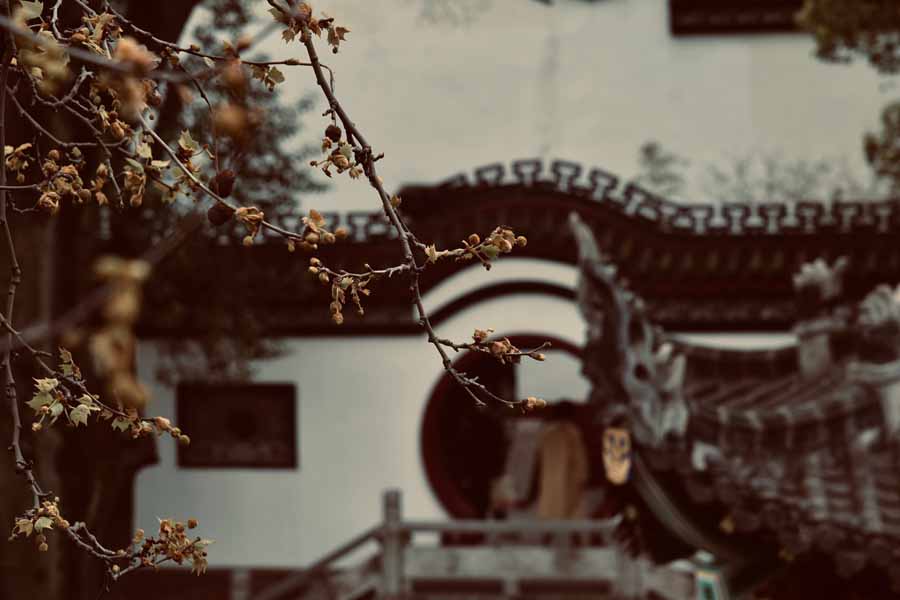During the long history of the Chinese nation, two main garden traditions have gradually formed: the vast imperial gardens and the private gardens. The former was emblematic of the power and wealth of the empire; the latter was the residence of literati and scholars who retreat from the onerous world of officialdom.
History of Chinese Gardens
The earliest references to gardens in China are found in Zhou Dynasty records describing vast tracts of land to be reserved for hunting parks for kings and princes. Success in the hunt was a metaphor for a successful reign. Later, in the Songs of Chu, a 4th century BC text, a shaman singer attempts to entice the soul of a dying king back to life with a description of the beauties of a garden with winding streams, lotus lakes, and distant views of the mountains. In the Shanglin Park of China’s first emperor Qin Shi Huang, they were countless animals, birds, and exotic plants gathered as tribute from vassal states, thus creating a living replica of his entire domain. Poets such as the famed Tao Yuanming (365-427) recorded in verse the pleasures of strolling through one’s garden. Both the Sui and Tang dynasties saw the further development of imperial and individual gardens. Wang Wei (699-759) created his Wangchuan villa in Lantian County, Shaanxi, a rustic retreat immortalized in poetry and paintings for centuries as the epitome of the scholar’s retreat.
The Song Dynasty gave rise to the proliferation of urban literati gardens, and at Kaifeng, Emperor Song Huizong (1082-1135) erected the Gen Yue Mountain, an artificial construct approximately seventy-seven meters tall, including many famous garden rocks. Kublai Khan (1214-1294) of the Yuan Dynasty built Beijing an extravagant city complete with lakes and hunting parks. The subsequent Ming Dynasty revised and embellished the Forbidden City with myriad courtyards and gardens and developed the Park of the Sea Palaces, a vast complex of gardens and retreats for the imperial family. The most famous of the gardens of the Qing Dynasty was the old summer palace(imperial Yuanmingyuan), within the precincts of which were countless watercourses, pavilions, libraries, farms, training fields for the emperor’s soldiers, and European-style fountains and buildings.
Cosmology of Chinese Gardens
The unique character of Chinese gardens has its roots in Chinese philosophy, most notably Taoism. A garden was seen as a mirror of the natural world. Everything in the universe was created from conduct for chi (vital energy, or life force). The universe was understood to be a combination of yin and yang elements in a state of constant fluidity. A balance of opposites in the construction of buildings, natural features, and plantings was a goal of the garden designer. Recreating the natural world in a garden was thought to replicate the benefits of immersing oneself in nature, a belief similar to ideas about the benefits of landscape painting. Scholars whose official duties prevented them from visiting the mountains could enjoy the benefits of nature in their own gardens. The ancient practice of Fengshui (literally, “wind-water”, often translated as geomancy) consisted of situating homes, buildings, graves, and gardens properly in a landscape to receive the optimum benefit.
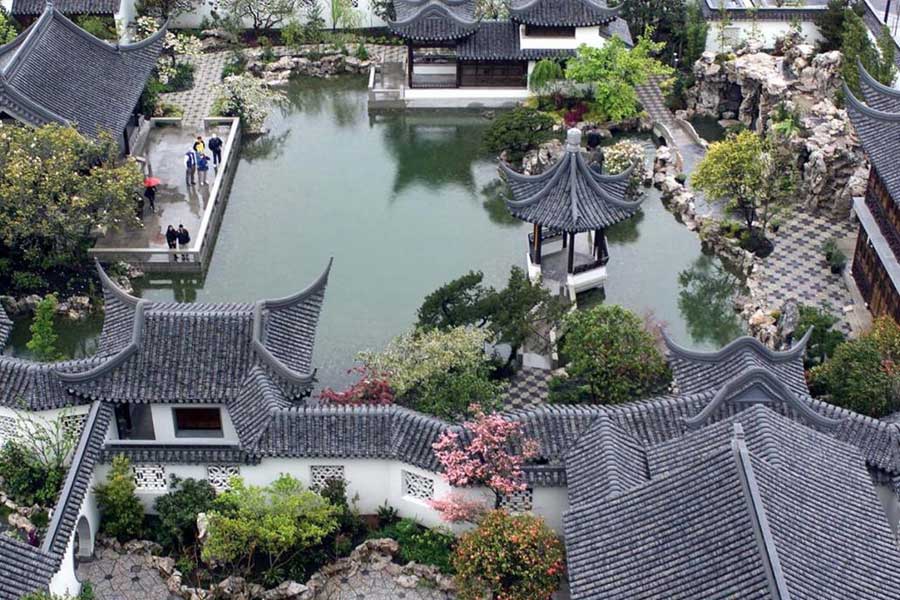
Traditional Chinese thought places humans as a small part of the infinite universe. Each living creature is a part of nature and the intrinsic link between humans and nature can’t be broken. Chinese gardens are an effort to imitate nature in their homes, to conform to nature without breaking this fundamental connection. Each part of the garden is meant to highlight and remind visitors of the harmony between humans and nature, with the goal of breeding harmony between character and emotion.
Imperial gardens symbolized the supreme power of emperors but were also places of recreation. Private gardens were places of relaxation and contemplation, a sanctuary to satisfy people’s longing for nature. Regardless of geographic location or scale, Chinese gardens represent a Chinese tradition of finding harmony within the world by turning to nature.
Elements of Chinese Gardens
The two main elements of a garden are water and rocks, symbolizing the yin and yang, respectively. Traditional Chinese gardens are constructed in a series of walled outdoor courtyards, joined by walkways or doorways. The use of garden rocks (yang) at strategic locations within a garden brings to mind the mountain ranges and peaks of nature. The incorporation of a watercourse, pool, lake, or cascade adds the water (yin) and all its mutable forms. Plants are included for literary and cultural references, for seasonal suitability, and for aesthetic reasons, such as the beauty of their shadows against the light garden walls, or the harmony of the sound of wind and rain in their foliage. Buildings such as ting (pavilions with open sides), xie (gazebos), tang (formal halls), and covered walkways make accessible the featured sites in the gardens and the effects of the changing hours of the days and seasons.
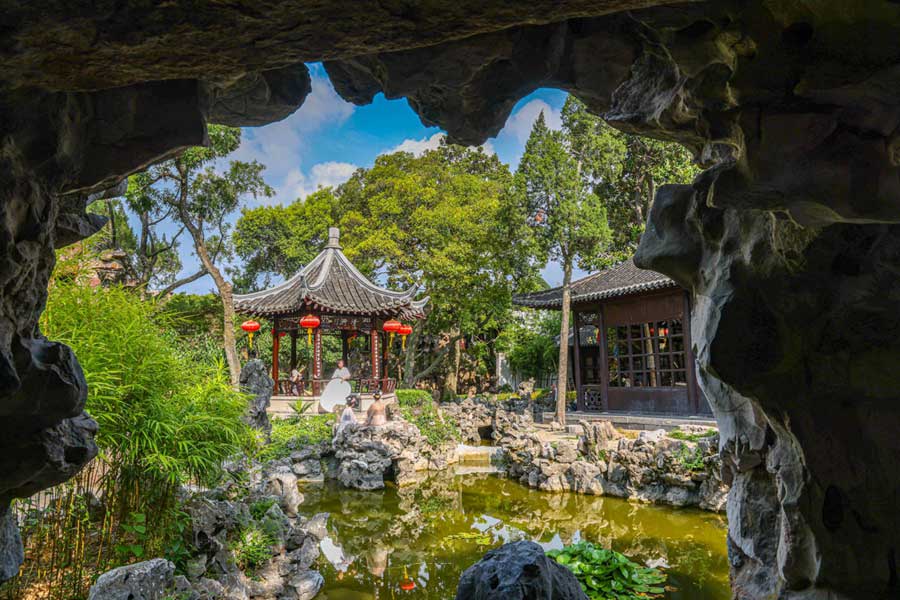
Such garden structures are named with references to classical literature, and the addition of calligraphy adds another layer of appreciation to the garden. Often potted plants are placed in courtyards at the peak of their blooming seasons, and pools and lakes water lilies, lotus, and fish. Gardens also include rockeries that are constructed of aggregates of bizarrely shaped rocks made into miniature mountains or roofs for artificial caves, both symbolic of the entrance to the realms of immortals and useful as an escape from the heat of summer.
Yuan Zhi (The Craft of Gardens, datable to 1631-1634), written during the late Ming Dynasty by Ji Cheng, is considered the classic text on garden design. Encompassing both practical and aesthetic advice, the manual advises the garden designer to be sensitive to the proper use of contrasts and juxtapositions of elements and to seek the essence lying behind the forms.
Ancient Chinese Garden and Its Culture
Ancient Chinese gardens were created in the same way as a combination of landscapes and paintings together with poems – this was the so-called “poetic garden”. The design of Chinese gardens was to provide a spiritual utopia for one to connect with nature, come back to one’s inner heart, and come back to ancient idealism. Chinese gardens are a spiritual shelter for men, a place they could be far away from their real social lives, and close to the ancient way of life, their true selves, and nature. This was an escape from the frustration and disappointment of the political problems in China. They used plants as symbols. Bamboo was used in every traditional Chinese garden. This is because bamboo represents a strong but resilient character. Often pine is used to represent longevity, persistence, tenacity, and dignity. The lotus is used to symbolize purity. The flowering plum is one of the most important aspects of a Chinese garden, as it represents renewal and strength of will. Flowering peaches are grown for spring color. The chrysanthemum is used to symbolize splendor, luster and “the courage to make sacrifices for a natural life”. Peonies symbolize wealth and banana trees are used simply for the sound they make in the breeze (Read more: Chinese Flowers Symbolism: Top 10 Flowers in China).
1) Private Garden in China
In the old days private gardens in China were owned by bureaucrats, landlords, rich merchants, and scholar-gentry. During the Ming and Qing dynasties, private gardens were found all over China. In the north, most of them were built in Beijing. In the lower Yangtze River Valley, the majority of them were found in Suzhou and Hangzhou. In the south, private gardens were mostly in the Lingnan region. But among all the private gardens, those in the lower Yangtze River Valley were the most typical of Chinese garden culture – the nation’s four best-known gardens are all situated in this region: Anlanyuan Garden of Haining, Zhanyuan Garden of Nanjing, Lion Grove of Suzhou, and Qinyuan (Jichangyuan) Garden of Wuxi. Most private gardens are in cities. As extensions of dwellings, they are generally small in size but look elegant and tasteful, and they perform multiple functions such as lodging, get-together, study, theatrical performance, and sightseeing. With the limited space of a garden, nature is imitated in a fastidious way. The beauty of the natural landscape is condensed and reproduced in the form of artificial mountains and tree groves in a garden that could be visited and watched, and in which harmony is achieved between man and nature. In the meantime, no effort is spared to achieve a poetic grace and satisfy the fancy for a lofty and elegant lifestyle.
The Yuyuan Garden in Shanghai: A typical example of the South garden
The Yuyuan Garden is found in the southeast part of the old city of Shanghai. Pan Yunduan, who was the Sichuan Provincial Administrative Commissioner of the Ming Dynasty, built this private garden for his parents in 1559. It remains the only ancient garden in urban Shanghai, and for this reason, it is protected as a national cultural legacy. The Yuyuan Garden has had its fill of ups and downs. It has changed hands repeatedly and undergone major expansions on several occasions. The garden was also associated with many major historical events in Shanghai, but in terms of landscaping culture, it can well be regarded as a crystallization of the Chinese garden culture after the mid-Ming Dynasty. The Yuyuan Garden today is a veritable jungle of architectural structures, where the forms of artificial hills are reflected quiveringly in the ponds, and the entire place is hidden in the rich verdure of trees and plants. No wonder ancients praised it as the “best garden in the southeast”.
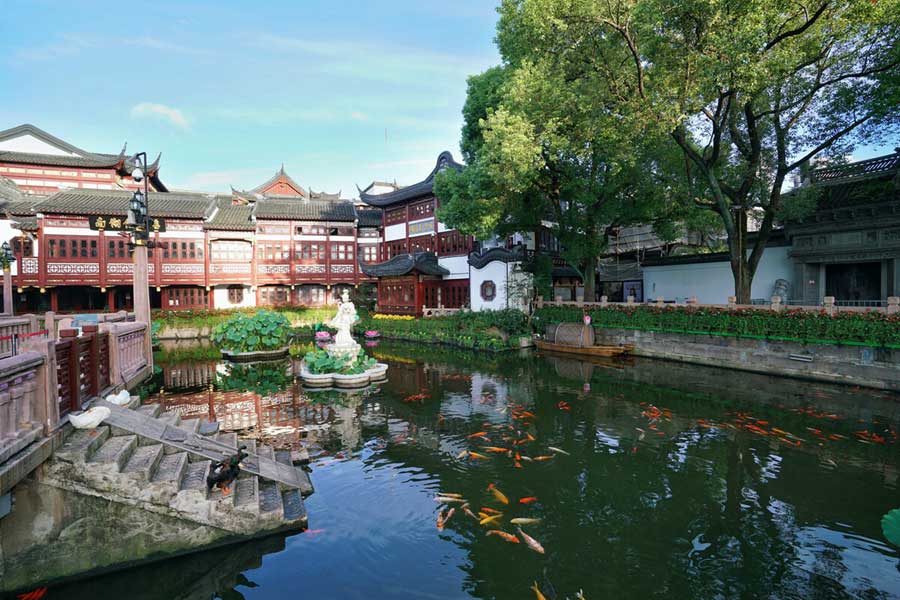
The Yuyuan Garden abounds with exotic scenes and sights. A total of 48 scenic views-chambers, halls, pavilions, kiosks, corridors, walls, trees, rocks, and ponds – are picturesquely laid out in this garden’s 20,000-square-metre space. The artificial hills look real, and so do the caves. Five dragon-shaped walls divide the garden into six scenic zones with distinct features. Of all the beauty spots in the Yuyuan Garden, the Giant Artificial Hill is definitely the best. In fact, it is the largest artificial hill built of yellow stone since the Ming Dynasty. Several thousand tons of stones were consumed in constructing this hill, whose main peak stands 12 meters tall. All the stones were quarried from Wukang County in Zhejiang Province. Both the textures of rocks and their shapes were taken into full account when this hill was being piled up to evoke a memory of the real thing. The presence of a footpath, cliffs, ravines, and streams has contributed to the realness the builders purported to achieve. A kiosk stands atop the hill to command the vista beyond the walls of the Yuyuan Garden.
2) Imperial Garden in China
The term “imperial garden” generally refers to those in which emperors lived and entertained themselves. Apart from the general features of classical Chinese gardens, imperial gardens are also marked by the following five salient features.
The guideline for the design of an imperial garden gives expression to feudal autocracy and reflects the idea that the Son of Heaven is the richest man under heaven.
There is a liberal choice of locations, and the construction of an imperial garden is backed up by abundant resources so that not only mountains and lakes in their original forms could be incorporated, but lakes dug, and mountains constructed, as well, in imitation of natural scenes. All sorts of buildings could be constructed, too.
The general layout of an imperial garden was magnificent, the buildings are beautiful or imposing and performed diverse functions, so that living in his imperial garden the emperor could administer state affairs, take up his lodging, receive tributes, feast his guests, watch theatrical performances, singing and dancing, martial arts contests, pay homage to the Buddha, collect books and treasures, observe crops, and go fishing and hunting.
Materials for the construction of gardens were wide-ranging, and vast numbers of artisans could be conscripted for this purpose, so that collective wisdom was pooled and the gardens were richly varied in form.
Most imperial gardens are situated in the north, and thus susceptive to the northern climate in so far as architectural tradition, coloration and the planting of vegetation are concerned. Despite keen efforts made to imitate famous gardens in the lower Yangtze Valley, these gardens still retain a style unique to the north.
Beijing’s imperial gardens are outstanding examples of classical Chinese garden culture; they are also part of the precious world cultural heritage. Among these gardens, Beihai Park, Jingshan Park, the Summer Palace, the old Summer Palace, and Xiangshan Park are the most famous ones. The Mountain Summer Resort of Chengde, 250 kilometers northeast of Beijing, is generally regarded as an extension of Beijing’s imperial gardens.
The Summer Palace in Beijing: A typical imperial garden
Situated in the western outskirts of Haidian District, the Summer Palace is 15 kilometers (9.3 miles) from central Beijing. Having the largest royal park and being well preserved, it was designated, in 1960 by the State Council, as a Key Cultural Relics Protection Site of China. Containing examples of the ancient arts, it also has graceful landscapes and magnificent constructions. The Summer Palace is the archetypal Chinese garden and is ranked amongst the most noted classical gardens in the world. In 1998, it was listed as one of the World Heritage Sites by UNESCO.
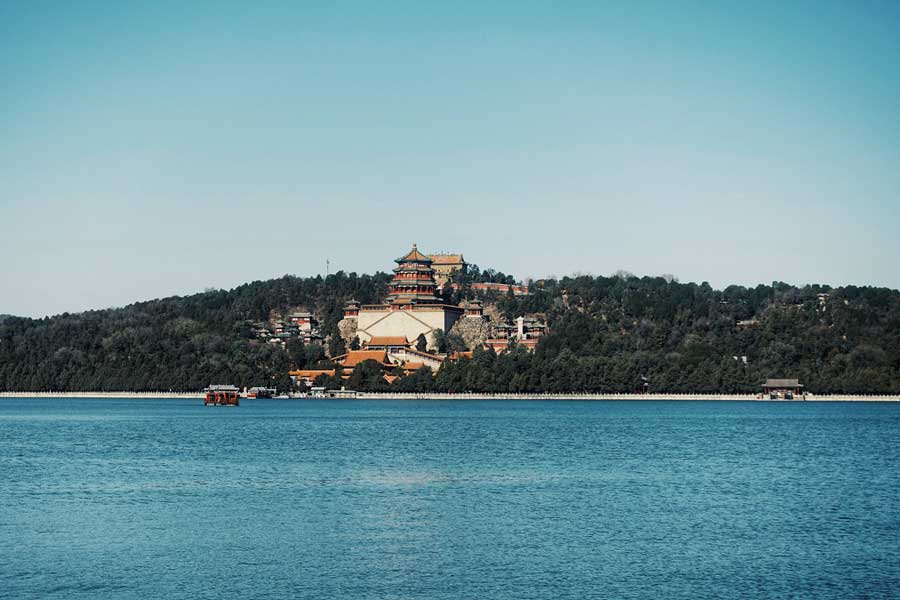
Constructed in the Jin Dynasty, during the succeeding reign of feudal emperors; it was extended continuously. By the time of the Qing Dynasty, it had become a luxurious royal garden providing royal families with rest and entertainment. Originally called Qingyi Garden (Garden of Clear Ripples), it was known as one of the famous “three hills and five gardens” (Longevity Hill, Jade Spring Mountain, and Fragrant Hill; Garden of Clear Ripples, Garden of Everlasting Spring, Garden of Perfection and Brightness, Garden of Tranquility and Brightness, and Garden of Tranquility and Pleasure). Like most of the gardens of Beijing, it could not elude the rampages of the Anglo-French Allied Force and was destroyed by fire. In 1886, Empress Dowager Cixi embezzled navy funds to reconstruct it for her own benefit, changing its name to Summer Palace (Yiheyuan). She spent most of her later years there, dealing with state affairs and entertaining. In 1900, it suffered again, being ransacked by the EightPower Allied Force.
Composed mainly of Longevity Hill and Kunming Lake, the Summer Palace occupies an area of 294 hectares (726.5 acres), three-quarters of which is water. Guided by nature, artists designed the gardens exquisitely so that visitors would see marvelous views and be amazed by perfect examples of refined craftwork using the finest materials.
Centered on the Tower of Buddhist Incense (Foxiangge) the Summer Palace consists of over 3,000 structures including pavilions, towers, bridges, and corridors. The Summer Palace can be divided into four parts: the court area, front-hill area, front-lake area, and rear-hill and back-lake area.
Front-Hill Area: this area is the most magnificent area in the Summer Palace with the most construction. Its layout is quite distinctive because of the central axis from the yard of Kunming Lake to the hilltop, on which important buildings are positioned including the Gate of Dispelling Clouds, Hall of Dispelling Clouds, Hall of Moral Glory, Tower of Buddhist Incense, the Hall of the Sea of Wisdom, etc.
Rear-Hill and Back-Lake Area: although the constructions are fewer here, it has a unique landscape, with dense green trees, and winding paths. Visitors can feel rare tranquility and elegance. This area includes scenic spots such as the Garden of Harmonious Interest and Suzhou Market Street.
Court Area: this is where Empress Dowager Cixi and Emperor Guangxu met officials, conducted state affairs and rested. Entering the East Palace Gate, visitors may see the main palace buildings: the Hall of Benevolence and Longevity served as the office of the Emperor, the Hall of Jade Ripples where Guangxu lived, the Hall of Joyful Longevity, Cixi’s residence, the Hall of Virtue and Harmony where Cixi was entertained.
Front Lake Area: covering a larger part of the Summer Palace, opens up the vista of the lake. A breeze fluttering, waves gleaming and willows kiss the ripples of the vast water. In this comfortable area, there are the Eastern and Western Banks, the Seventeen-Arch Bridge, Nanhu Island, and so on. On the western bank float six distinct bridges amongst which the Jade-Belt Bridge is the most beautiful.
The Influence of the Chinese Garden on the World
As early as in the 6th century, Japan had already known of Chinese garden landscaping through Marco Polo, who visited many Song Dynasty gardens in southern China during the Yuan Dynasty. In the 17th century, Chinese garden landscaping was introduced to England where it then spread to France and the rest of Europe. In the late 18th century, Chinese garden landscaping had a huge influence on the European Romantic Movement, and European landscaping moved away from a stiff aristocratic style to a more natural style found in Chinese gardens.
Western and Eastern garden landscaping bear different forms and styles because of different philosophies and a sense of aesthetic beauty. In form, Western landscaping embodies artificial beauty with symmetrical, regular and well-knit layouts. Geometry is ever-present as flowers and plants are pruned upright and square. Chinese garden landscaping doesn’t require symmetry or fixed regulations as plants, trees and buildings are built to a natural form. Whereas Western landscaping theory aims to remedy the defects of nature, Chinese garden landscaping blends plants and buildings into an organic whole and imitates nature by building mountains (rocky outcroppings) with flowing water to present a quality suggestive of poetry or painting. To fully enjoy the beauty of Chinese gardens, it’s important to understand the philosophy implied through the sceneries.

